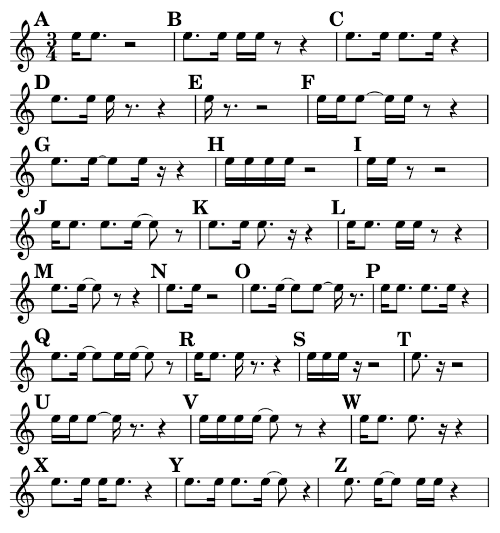Morse code in musical notation
Maybe this has been done before, but I haven't seen it: Morse code in musical notation.
Here's the Morse code alphabet, one letter per measure; in practice there would be less space between letters [1]. A dash is supposed to be three times as long as a dot, so a dot is a sixteenth note and a dash is a dotted eighth note.
Morse code is often at a frequency between 600 and 800 Hz. I picked the E above middle C (660 Hz) because it's in that range.

According to Wikipedia, the dit length at 20 words per minute is 50 milliseconds." So if a sixteenth note has a duration of 50 milliseconds, this would mean five quarter notes per second, or 300 beats per minute. But according to this video, the shortest duration people can distinguish is about 50 milliseconds. Something doesn't add up, because some people can copy Morse code at more than 50 words per minute; 20 words per minute isn't that unusual.
How the image was madeI made the image above with LaTeX and Lilypond.
Adding the letters above each measure was kind of a hack. I used rehearsal markings to label the measures, but there was one problem: the software skips from letter H to letter J. That meant that the labels I and all subsequent letters were one ahead of what they should be, and the final letter Z was labeled AA. I tried several tricks, and Lilypond steadfastly refused to label a measure with I' even though I've seen such a label in the documentation.
My way around this was to make it label two consecutive measures with H, then in image editing software I turned the second H into an I. No doubt there's a better way, but this worked.
I may play around with this and try to improve it a bit. If you have any suggestions, particularly related to Lilypond, please let me know.
Related posts[1] You could think of the musical score above as a sort of transcription of the Farnsworth method of teaching Morse code. Students learn the letters at full speed, but with extra space between the letters at first. The faster speed discourages consciously counting the dits and dahs, forcing the student to listen to the overall rhythm of the letters.
The post Morse code in musical notation first appeared on John D. Cook.